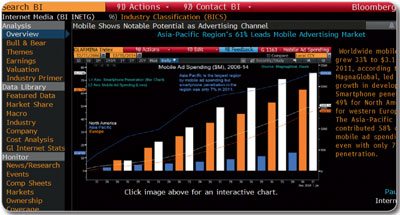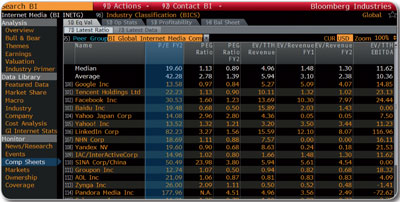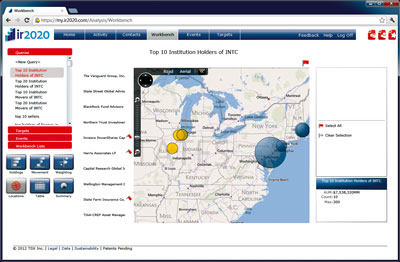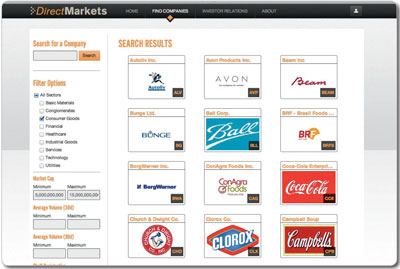The latest monitoring and controls applications go beyond traditional IR. Neil Stewart looks at how they can help steer your program
IR doesn’t come with a road map, but even though at its core it’s about developing relationships – often face to face – the idea of a dashboard, replete with an impressive array of gauges and controls, is compelling.
Right now, dashboards are hot: NYSE Connect, NYSE Euronext’s intranet for Big Board-listed companies, is billed as a dashboard of market information tools, while the StockTwits IR Suite is known as a social dashboard.
The most horsepower, however, belongs to the new Bloomberg Industries, a collection of ‘industry dashboards’ three years in the making.
An IRO’s go-to screen is likely a traditional customer relationship management platform with ownership data and other market intelligence, such as Thomson ONE Investor Relations, Ipreo’s BD Corporate or NASDAQ OMX’s Corporate Intelligence. It might even be a simple Excel spreadsheet used to keep track of contacts.
Any one of these could be the primary vehicle for IROs, their Toyota Camry for everyday use. But when they want to venture off the beaten path or feel the wind in their hair, what dashboard do they call up on their screen?
Bloomberg Industries: endless exploration in a Toyota Landcruiser
Years after you start exploring the world with this one, you’ll discover tools you didn’t know about. Bloomberg Industries, a new feature on the Bloomberg Professional service conceived as the first ever real-time research platform, rides atop a massive store of data and tools and is meant to be a fixture on the desks of analysts, bankers and corporates.
The idea is to take everything those professionals would normally get from static, soon-dated sell-side research and make it live and constantly updated.
Bloomberg Industries analysts’ insights build on a huge store of raw data
‘Our analysts identify the data appropriate for their industries, then figure out how to organize and present it so it’s continuous,’ explains Drew Jones, global business manager for investment banking, private equity and investor relations clients at Bloomberg.
In contrast to sell-side research, Bloomberg Industries gives no ratings, price targets or estimates. ‘It gives industry context and shows how a company fits within that context, which is exactly what an IR executive has to understand and be able to explain,’ Jones says.
For example, each analyst sets out both bull and bear cases for his or her industry, writes themed research and highlights the current hot topics from day to day. This might include quotes from earnings calls or breaking industry developments.
Monitoring comparable companies (‘comps’) on a Bloomberg Industries dashboard
There are more than 310,000 Bloomberg subscribers around the world and, for IROs, many are potential contacts via Bloomberg’s messaging systems.
‘It’s a built-in network, letting you find people and their contact information and see who’s online,’ says Jones, who adds that many IROs already use Bloomberg to chat live with portfolio managers and analysts: ‘It’s a much faster way to communicate with people.’
Bloomberg Industries has more than 100 industry analysts in the US, Europe and Asia, including 30 senior analysts with buy-side or sell-side experience. Asia is getting a big growth push, as are emerging markets in general, including Latin America in the near future.
Bloomberg Industries was demoed at the last two national NIRI conferences. IROs looked slightly befuddled as the analysts’ fingers flew over the keys, summoning up screen after screen of data, but the firm vows its terminals are easier to use since its revamp early this year, with a simpler search engine, a more consistent interface and more logical workflow.
‘We want our clients to spend less time finding and manipulating data and more time creating value-added investment ideas,’ says David Dwyer, who heads up Bloomberg Industries.
TMX Group’s ir2020: a Mini Cooper – fast, nimble and good looking
When ir2020’s Ken Watson set out in 2008 to build a better customer relationship management (CRM) for investor relations, he brought years of experience thinking about user-friendliness for Microsoft, most recently as release manager for Visual Studio. Agnies Watson, his wife and co-founder, had worked in corporate finance and most recently in investor relations at Microsoft for a year.
The result is much more image-oriented than a typical CRM, with ‘visualizations that help IR professionals explore institutional holding data,’ Ken says.
Agnies had experienced firsthand the challenges an IRO faces with traditional holding data: exporting it to Excel for analysis or to create reports, often doing the same laborious tasks quarter after quarter. The platform she and her husband created, which TMX Group bought in early 2012, began with a series of images before any software was even written.
Different ways of visualizing data on ir2020 help bring it to life
It’s not just a collection of pretty pictures, though. Ken says the contact management tools flow seamlessly from the analysis, ‘making sure the research you do as you explore the data leads naturally into action. Our philosophy was to understand what IROs are doing and how they could do their job more quickly. How we got there was by paying attention to user experiences, how to present the data, and how to help the user explore the data without letting visualizations get in the way of understanding.’
Ken says other CRM products for IROs have more of a capital markets heritage. ‘The feedback we got from IROs is that they prefer to visually explore the data rather than spend a lot of time in spreadsheets,’ he notes.
He also had the advantage of quickly building a new CRM using the latest web technology with none of the baggage of previous generations of the product; the result is a product that’s intuitive to use and visually appealing.
One example of this is a portfolio pivot table showing an institution’s holdings as a chart colored according to whether each stock is a heavy buy, a heavy sell or flat. Zooming in reveals more detail, as though flying into a fractal landscape, and each stock even has a ‘speedometer’ that wouldn’t look out of place on a sports car’s dashboard.
TMX Group’s ir2020 is a subscription-based product, currently focusing on the Canadian market – but it is just as suited to other markets, says Ken.
The StockTwits IR Suite: a Nissan Leaf, running on nothing but tweets
Unlike the other dashboards profiled here, which are fuelled by masses of data, StockTwits’ product for IR teams relies only on what’s tweeted on StockTwits, including anything a company itself might choose to post.
A Nissan Leaf can’t go too far on a charge, but the StockTwits IR Suite is surprisingly far-reaching because of distribution agreements with CNNMoney, Yahoo! Finance, Reuters.com and Investopedia, as well as new deals struck to incorporate StockTwits into Thomson Reuters’ social media releases and PR Newswire’s Capital Markets Visibility 365 product. 
Subscribers to the StockTwits IR Suite get a dashboard with all their messaging and monitoring tools
The part of the StockTwits IR Suite that will be of most interest to IROs isn’t the part that helps companies live-tweet earnings calls like LinkedIn, Dell and eBay do.
Rather, it’s a ‘social dashboard’ that looks at investor sentiment, with various ways of monitoring what’s going on in the wider StockTwits world.
Francis Costello, chief operating officer of StockTwits, says the service has focused on the three distinct stages of a company’s involvement in social media.
‘The first stage is monitoring and understanding the conversation,’ he explains – thus the StockTwits IR Suite includes lots of gauges and email alerts for message volume and trending of certain stocks, particularly peers.
Unlike a broader social media monitoring service like Marketwire’s Sysomos, which scans blogs, Facebook and the wider web, StockTwits’ monitoring tools focus only on their own platform. ‘It’s much more about what’s happening in the investor conversation,’ Costello says. 
Analytics track a corporation’s communications across StockTwits and its distribution partners
The second step is active tweeting, initially to amplify existing communications – with a link to a press release, say. Monitoring is possible here too, though: distribution analytics track where a company’s messages are being sent and whether they’re being viewed.
‘The folks who go the final step start enhancing the messages they’re sending out, perhaps soliciting questions in the social sphere,’ Costello says.
StockTwits has a slick, modern interface with an ‘enterprise dashboard’ that gives a single point of access for messaging, analytics and other tools.
Costello says he has been talking to customers about the next steps in monitoring and analyzing the StockTwits world. One possibility: easily exported reports ready to pass up the management ladder to show social media progress.
DirectMarkets: fit the whole finance team in a Ford F-150 SuperCrew Cab
Unveiled last March by investment bank Rodman & Renshaw, DirectMarkets is billed as the first ever electronic trading platform to link issuers directly with investors for primary offerings and buybacks, potentially bypassing the traditional investment banking role.
Kevin Lupowitz, one of the founding employees and chief information officer of the dark pool Liquidnet, was drafted as CEO of DirectMarkets this year. He thinks of it not as a dashboard but as ‘an ecosystem, bringing together issuers, investors and partners’.
DirectMarkets’ breakthrough is to let issuers sell shelf registration shares directly into the secondary market. Investors can also contact issuers with shelf registrations to indicate interest and potentially start negotiations, letting both sides save on spreads and transaction costs.
Follow-on offerings, registered directs, at-the-markets (ATMs), confidentially marketed public offerings and private investments in public equities all stand to be transformed by the platform.
Lupowitz sees DirectMarkets as being like LinkedIn for companies and their investors – a social network replete with corporate profiles and other information. ‘Through our platform they can immediately get more institutional eyes on their information than just having a website achieves,’ he says. 
DirectMarkets functions like a social network for firms and investors
Basic data for 10,000 issuers is already available on DirectMarkets. For a monthly fee of $7,500, issuers can put up original content such as videos or management profiles – just about anything they have on their current IR websites – and get access to ‘shelf match’, ‘closing room’ and other ways to transact offerings.
Content can be limited to specific firms or individuals, making virtual deal roadshows possible. Analytics come into play, too: who’s looking at what, and how far they’re getting into it.
DirectMarkets is ‘broker neutral’, meaning it isn’t dependent on just its own liquidity pool. ‘We’re tapped into all the liquidity pools and all the execution venues,’ Lupowitz says. ‘You can do an ATM and make it open to all investors in our system, but at the same time we can have it out in all the different liquidity pools. In one fell swoop, the issuer gets complete exposure for that order.’
DirectMarkets was at NIRI’s national conference in Seattle this year, looking to partner with investor relations firms and add social media sentiment, news and quant analysis, and company website feeds to the platform. The company has already partnered with transfer agents to make offerings seamless.
‘An efficient secondary market already exists – liquidity pools and execution venues, but all for secondary trading,’ Lupowitz concludes. ‘The primary market has shares to introduce into that market. There’s no reason why it can’t electronically bridge that gap through our platform.’










